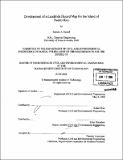Development of a landslide hazard map for the island of Puerto Rico
Author(s)
Kamal, Sameer A. (Sameer Ahmed)
DownloadFull printable version (17.07Mb)
Other Contributors
Massachusetts Institute of Technology. Dept. of Civil and Environmental Engineering.
Advisor
Rafael Bras.
Terms of use
Metadata
Show full item recordAbstract
This thesis describes the development of a landslide hazard map for the island of Puerto Rico through the use of Graphical Information System (GIS) tools. Parameters considered in this study are elevation, slope aspect, slope angle and land use. This study employed data for a total of 2,966 landslides. The elevation and land use analysis was conducted on the entire landslide dataset, while the slope aspect and slope angle analysis was conducted on a smaller subset (366 landslides). This work builds on previous landslide studies in Puerto Rico by employing a 5-m Digital Elevation Model (DEM) for the slope angle and slope aspect analysis. The major steps involved in the landslide hazard map generation are: a categorization analysis to determine relative hazards for each parameter, assignment of weights to each parameter based on their range of relative hazard values, and a consolidation of results from each parameter that is analogous to a multi-factorial analysis. Results indicate that slope angle is the dominant factor (87.5%) in determining landslide hazard, followed by elevation, slope aspect and land use. The slope angle results were found to be very sensitive on the choice of sampling methodology and data resolution. . In particular, the 5-m DEM provides significantly more detail than available for previous analyses and results in much greater sensitivity of risk to slope angle. Further study is recommended into issues relating to the resolution at which the landslide data is obtained and normalized, as well as an inclusion of other parameters (such as soil type and geology) into this landslide hazard assessment.
Description
Thesis (M. Eng.)--Massachusetts Institute of Technology, Dept. of Civil and Environmental Engineering, 2008. "June 2008." Includes bibliographical references (leaves 46-48).
Date issued
2008Department
Massachusetts Institute of Technology. Department of Civil and Environmental EngineeringPublisher
Massachusetts Institute of Technology
Keywords
Civil and Environmental Engineering.